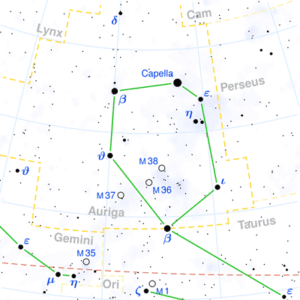Image credit : Torsten Bronger CC BY-SA 3.0 Published in seasky.org
M36 is an open cluster comprising approximately 60 stars of which about 40 stars are visible in most amateur telescopes. It is approximately 3,900 light-years away and is about 14 light-years across. It is is the smallest and the most concentrated of the three clusters.The open cluster M37 appears larger than M36 and lies at a distance of approximately 4200 light-years. It comprises about 150 stars the most prominent of which is an orange star at its centre. M37 is approximately 25 light-years in diameter It is the brightest open cluster in Auriga
The open cluster M38 is the least concentrated of the three clusters in Auriga and lies at a distance of approximately 3900 light-years from our sun. It has an apparent diameter of approximately 20 arcseconds and a true diameter of about 25 light-years. It has a much more varied stellar population than M36 and M37. M38 is accompanied by NGC 1907, a smaller and dimmer cluster that lies half a degree south-southwest of M38.
IC405, the Flaming Star Nebula, is a reflection / emission nebula surrounding a blue-white star. IC405, along with its neighbours IC 410, IC 417, and NGC1931 makes a fine target for wide field imaging.
There are several minor meteor showers with their radiant in Auriga. The most well known shower is the Alpha Aurigids (“the Aurigids”: August-September) but there is also the Delta and Zeta Aurigids. The Zeta Aurigids is a weak shower lasting from December 11 to January 21 and reaching a peak on January 1. It has very slow meteors, with a maximum rate of just 1 to 5 meteors per hour.

